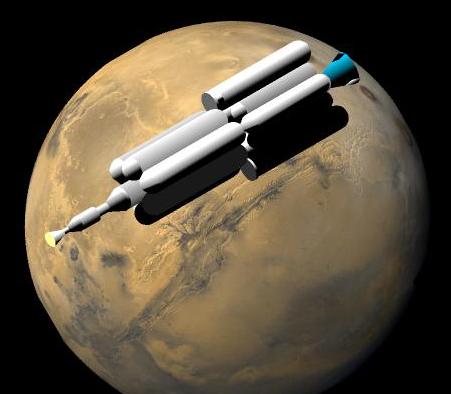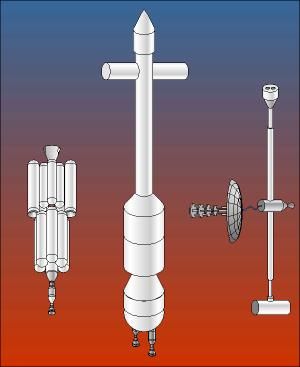
Home - Search - Browse - Alphabetic Index: 0- 1- 2- 3- 4- 5- 6- 7- 8- 9
A- B- C- D- E- F- G- H- I- J- K- L- M- N- O- P- Q- R- S- T- U- V- W- X- Y- Z
EMPIRE Aeronutronic

Empire
Ford Nucleonics Emprie Design
Credit: © Mark Wade
AKA: Early Manned Planetary - Interplanetary Roundtrip Expedition. Status: Study 1962. Thrust: 1.78 kN (401 lbf). Gross mass: 170,000 kg (370,000 lb). Specific impulse: 800 s. Height: 47.00 m (154.00 ft). Diameter: 14.00 m (45.00 ft).
The 21-month mission would be launched toward Mars during a 28 day window opening on 19 July 1970.
EMPIRE was the first series of Mars mission studies conducted under NASA's auspices. The goal of the studies was to identify mission alternatives and estimate spacecraft masses for initial manned Mars flyby and orbiter missions. The primary objective was to identify payload requirements for Nova, the series of super heavy lift launch vehicles planned after the Saturn series. A secondary objective was to identify stage and engine requirements for NERVA, the AEC/NASA nuclear thermal engine program. The Marshall Space Flight Center's Future Projects Office, led by Heinz Koelle, let contracts for the studies to industry in May 1962. Three contractors were selected: Aeronutronic, General Dynamics, and Lockheed.
Aeronutronic's flyby spacecraft had a total mass of 170 metric tons, a length of 47 m, and would be launched into low earth orbit by a Nova booster with a payload capability of 227 metric tons. The 21-month mission would be launched toward Mars during a 28 day window opening on 19 July 1970. A single nuclear thermal engine of 182 metric tons thrust would fire for 1000 seconds at trans-Mars injection. Two sets of 8 propellant tanks surrounded the nuclear stage and the upper spacecraft. The four lower tanks were jettisoned as depleted during the engine burn. The four upper tanks around the spacecraft were retained to provide additional meteoroid and radiation protection during the trip to Mars and back. The nuclear stage was jettisoned after burnout. The spacecraft then deployed two primary living modules on booms. The spacecraft would then be spun up to 3 rpm to provide 0.3 G gravity for the crew during the mission. The crew was provided with a total of 4500 cubic meters of living space in the living modules, together with 300 cubic meters in a radiation 'storm cellar' at the center of the spacecraft, for use during solar flares.
Aft of the spacecraft large radiator panels would deploy to dissipate heat from a SNAP-8 radioisotope thermal power generator, which provided power. At the forward end of the spacecraft a lifting-body re-entry vehicle was docked. During the mission midcourse corrections were provided by conventional chemical rocket engines. As the spacecraft neared the earth, the crew would enter the re-entry vehicle. A two-stage conventional braking rocket would slow the RV to an acceptable velocity for re-entry. A follow-on mission that would swingby both Mars and Venus with a 1972 launch was also proposed.
EMPIRE Aeronutronic Mission Summary:
- Summary: First contractor study to NASA for design of a Mars flyby spacecraft
- Propulsion: Nuclear thermal
- Braking at Mars: flyby
- Mission Type: Crocco
- Split or All-Up: all up
- ISRU: flyby
- Launch Year: 1970
- Crew: 6
- Total Mission Time-days: 630
- Total Payload Required in Low Earth Orbit-metric tons: 227
- Mass per crew-metric tons: 37
- Launch Vehicle Payload to LEO-metric tons: 330
- Number of Launches Required to Assemble Payload in Low Earth Orbit: 1
- Launch Vehicle: Nova MM 1B
Crew Size: 6. Habitable Volume: 4,800.00 m3.
Family: Mars Expeditions, Mars flyby. Country: USA. Engines: Nerva-1. Propellants: Nuclear/LH2. Agency: Aeronutronics. Bibliography: 49, 591.
 | Empire Comparison Comparison of Empire designs, from left to right: Credit: © Mark Wade |
Back to top of page
Home - Search - Browse - Alphabetic Index: 0- 1- 2- 3- 4- 5- 6- 7- 8- 9
A- B- C- D- E- F- G- H- I- J- K- L- M- N- O- P- Q- R- S- T- U- V- W- X- Y- Z
© 1997-2019 Mark Wade - Contact
© / Conditions for Use